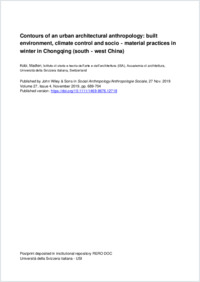Contours of an urban architectural anthropology : built environment, climate control and socio‐material practices in winter in Chongqing (south‐west China)
- Kobi, Madlen Istituto di storia e teoria dell’arte e dell’architettura (ISA), Accademia di architettura, Università della Svizzera italiana, Switzerland
-
27.11.2019
Published in:
- Social anthropology/Anthropologie sociale. - 2019, vol. 27, no. 4, p. 17 p
English
The materiality of and daily life in urban high‐rise buildings has barely been researched, especially when compared to the rich anthropological and architectural studies that exist on rural architecture. This article engages with indoor climate control in an urbanising environment. It considers urban architecture as a social field characterised by the interaction of diverse actors such as architects, policymakers, investors and residents. Based on ethnographic data from subtropical Chongqing (China) in winter, the broader aim is to outline an urban architectural anthropology that approaches the house from a holistic perspective with regard to its materiality, namely by considering both its structure and interior architecture, all embedded in the larger political and economic context. With regard to thermal comfort, architects often focus on the qualities of the material structure of a building for indoor climate control, while social science approaches tend solely to consider the objects and practices inside those structures. In following a practice–arrangement nexus approach as put forward by Schatzki (2010), I propose to think the two levels as interrelated. Ethnography‐based research thus contributes significantly to grasping how people react to buildings and make themselves comfortable in social, socio‐ material and thermal terms.
- Language
-
- English
- Classification
- Architecture
- License
-
License undefined
- Open access status
- green
- Identifiers
-
- RERO DOC 329559
- DOI 10.1111/1469-8676.12718
- ARK ark:/12658/srd1319354
- Persistent URL
- https://n2t.net/ark:/12658/srd1319354
Statistics
Document views: 211
File downloads:
- Fulltext: 282
